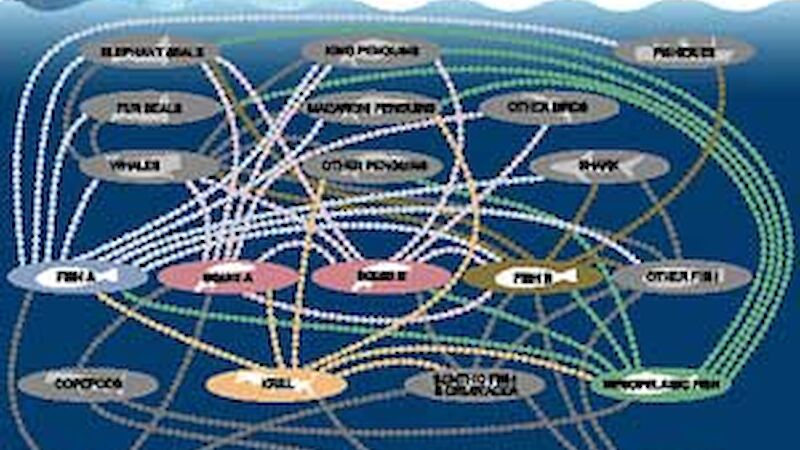Why is it that a statement of rather obvious logic like ‘whales eat fish’ has come to represent a pivotal debate about the way we manage and conserve our fisheries? The answer to this lies in the international politics and science that play out in the International Whaling Commission (IWC). In this, and other forums, several pro-whaling nations have raised the case that resources consumed by whales affect global food security, and that the resumption of whaling would result in more resources being available for commercial fisheries. The consequences of this, and similar debates about other predators (such as seals), have major socioeconomic implications.
Whales are a highly diverse group of marine mammals that exist in all our oceans. Their diet is varied, and whilst the baleen whales in the Southern Ocean feed almost exclusively on krill, fish — not surprisingly — can also be a dietary component of some whales. Poor regulation of whale hunting during the whaling era drove most of the great whale species close to extinction. Over the past few decades we have witnessed the early stages of recovery of a number of whale stocks, whilst others remain seriously threatened. The gradual re-emergence of some of these highly visible species has been used by some of the pro-whaling nations to stimulate the long-standing, polarised debate about the way in which marine predators such as whales might limit or influence fisheries, and to further the case in favour of the resumption of commercial whaling. A case is gradually being developed to consider ecosystem manipulation, whereby predator numbers, such as whales, are reduced with a view of making additional biomass available to commercial fisheries.
The type of interactions in question here are not the operational ones such as killer whales taking fish from a commercial long-line, but rather, the more complex interaction at the level of the food-web, whereby predators, including man and whales, might be competing directly for a food species. The fundamental premise behind the idea of manipulating a food web, or ecosystem, is that if you were to cull a number of whales, then the food that is not consumed by those whales will be available to commercial fisheries. How likely is this?
The scientific debate on this has been, and continues to be, controversial and polarised. To a great extent this reflects the complexity of ecosystem structure and function and our limited capacity to measure and predict it. At its most simple, a food web model consists of a series of boxes, each representing a species in that food web, with arrows indicating who eats who. At its next level of complexity the size of the arrows between predators and prey might be scaled, so that the size of the arrow represents the relative importance of a particular prey species to a particular predator. An example of a highly simplified food web is given in the figure below. In this system, which is one that might operate in the Southern Ocean, you can see that there is an arrow between Fish B and whales. This reflects the likely fact that Fish B contributes towards some part of the diet of animals such as killer whales, sperm whales and beaked whales. What is also evident is that elephant seals, sharks, other fish and fisheries also ‘eat’ Fish B. This consumption is of course not only at the stage of mature fish, but may be at any stage of the fish’s life cycle. Thus, it may be that some relatively small fish are eating masses of juvenile Fish B. Indeed, where data of this type have been assessed previously in relatively well studied ecosystems, it is usual that ‘other fish’ contribute enormously more to the mortality of a commercial prey species than do marine mammals.
If we imagined that we were to remove the whales from our simplified food web model, then their contribution to the mortality of Fish B would also be removed. From the point of view of the fisheries the best outcome of this would be that this hypothetical surplus of fish would now be available for us to catch. There are several things that make this outcome unlikely. Firstly, the other predators of Fish B are likely to want a share of this possible surplus, so at best only a portion remains for the fishery. Secondly, you will notice that there is also a line from ‘other fish’ to whales. This means that there will also be more of these ‘other fish’ left in the water after the hypothetical demise of our whales, and these additional ‘other fish’ will require more Fish B to sustain them. This again depletes the potential surplus for our fishery. More generally the obvious complexity of even this simplified food web means that the adjustment of the relationship between just one predator and one prey is likely to change the myriad of other relationships in the food-web in a way that is likely to be subtle and extremely difficult to predict. Finally, the figure is like a snap-shot of relationships. In reality we know that these relationships are highly dynamic and subject to large scale changes, dependent upon a complex interaction of competing influences.
The Australian Antarctic Division is required to provide scientific advice to organisations like CCAMLR to support the sustainable utilisation of fisheries in the Southern Ocean. To this end, much of the research we undertake aims to improve our knowledge of how marine predators, such as whales, and their prey interact within their complex food webs, and how we might improve our ability to predict changes from processes such as fisheries or climate change. Given the difficulty of this task, and the high possibility of making erroneous predictions, CCAMLR invokes the precautionary principle in any management action that results from this, or other research.
Nick Gales,
Antarctic Marine Living Resources Program, AAD

